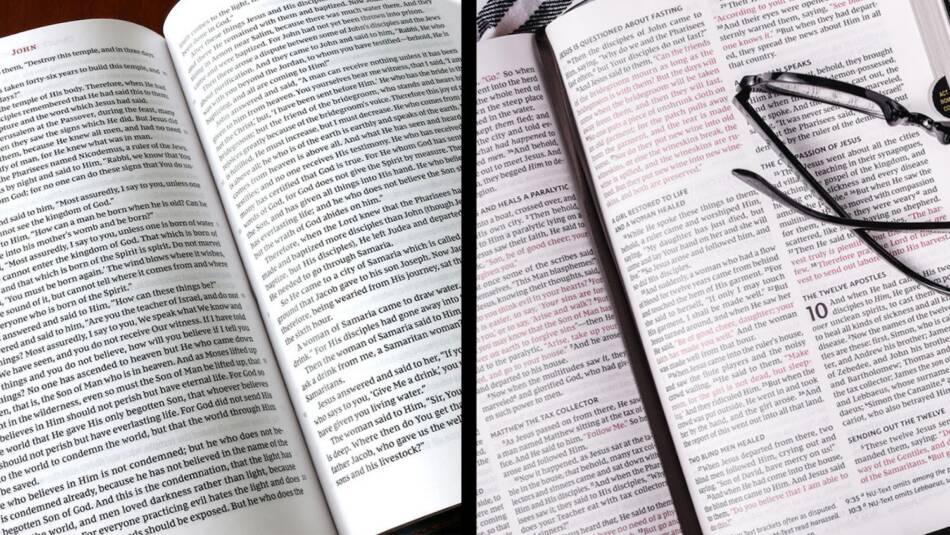When we open the Bible to the Gospels, the first thing that stands out is whether or not the words of Christ are in red. Not all Bibles have red-letter or indicate the words of Christ differently from the rest of Scripture. There are personal preferences for both types and it can be difficult to decide between them. Let’s look at red-letter vs black-letter to help you decide which is best for your needs.
First: About the Text
First, the Bible is a unity. All of the words in the Bible are inspired. The words of Jesus are from God (John 12:49), the writings of Paul are from God (2 Peter 3:16), the Old Testament writers were moved by the Spirit of God (2 Peter 1:21), all Scripture is inspired by God (2 Timothy 3:16). The color of the text isn’t meant to elevate one portion of God’s Word over another.
About Red-letter Bibles
The primary purpose of red-letter is to honor the words of Christ. Some have taken red-letter to an extreme and only read the words that are in red. Others presume that only the words in red are important, or that they’re more important. They use red-letter editions so they can focus on the teachings of Jesus.
This isn’t the intent of red-letter Bibles. Red-letter isn’t more inspired than black-letter. It’s not intended to show degrees of inspiration or superior words. It just identifies the words of our Lord.
Red-letter is handled in different ways. Some editions only include the words of Christ while on Earth. It’s sometimes unclear who the speaker is, so not all translations and publishers include the same words or verses in red.
History of Red-letter Bibles
Red-letters in the Bible are a fairly new concept in Bible publishing. We’ve only had them for a few generations. The first red-letter New Testament was published in 1899. The full Bible with a red-letter New Testament was printed in 1901.
Lous Klopsch, the editor of Christian Herald magazine, is the originator of the red-letter concept. The idea came to him when reading Luke 22:20, which describes the new covenant in Christ’s blood. Klopsch then wanted to print all of the words of Christ in the color of blood.
It was printed and published by Christian Herald. It was a success and several Bible publishers, including Thomas Nelson, quickly released similar editions.
The original red-letter concept extended to the Old Testament to show how extensively the scarlet thread of redemption is interweaved through Scripture. The first red-letter Bible printed cross-references to passages that Jesus referred to in red. Old Testament passages with prophecies concerning Christ were marked with a red star. Several scholars assisted in this work.
Pros
- Red-letter honors Christ.
- Red-letter is helpful when you want to find the words of Jesus quickly. This is especially helpful in the King James Version, since it does not include quotation marks for dialog.
- It’s helpful in study.
- Finding the words of Christ is much easier and faster when preaching or teaching.
- Color can break up the page, making it visually appealing.
- A well-printed red, like Thomas Nelson’s Comfort Print®, can make the page more attractive and visually interesting.
Cons
- Red-letter can be more difficult to use if you highlight your Bible. The colors you choose for your highlights have to work great with two different colors of text. This is also true of notes that you make in the margins.
- Red that is too bright can be hard on your eyes. This is especially true for lengthy reading sessions.
- Red doesn’t have as much contrast with the white page as black does. This can make it difficult to read. The red ink needs to be dark or bright to stand out from the page.
- It can be difficult to know which words Jesus said, which were paraphrased by the writer, whether or not to include someone else quoting Jesus, etc. Sometimes they’re his ideas rather than his actual words. This is why we see different phrasing between the Gospels. We can’t be 100% certain where Jesus ends his message in John 3.
- It’s more difficult, and expensive, to keep the printing consistent.
- Every publisher, and many Bibles from the same publisher, have a different shade of red. Even if the printing within the Bible itself is consistent, the red might be much different from one model to the next.
- It makes it easier to develop doctrine incorrectly.
About Black-Letter Bibles
Traditionally, all of the text of Scripture was in black-letter. The original writings and the thousands of copies do not differentiate the words of Christ from the rest of the text. Nothing is devalued as it’s all the inspired word of God. Black-letter is still popular and many Bible readers, students, and preachers prefer it.
Pros
- Black text on white paper is easier to read.
- Black-letter is easier to read in a larger variation of lighting.
- It usually causes less eye strain and fatigue.
- Nothing stands apart to give the impression of a different value or quality of the words spoken.
- It’s a better option for long periods of reading.
- Marking is less cluttered visually. Colors chosen for marking doesn’t have to look good with two different colors of text.
- It can be easier to preach from in different types of lighting.
- It’s easier to pay attention to all of the text.
Cons
- The teachings of Jesus are more difficult to find quickly.
- Other elements in the layout must be used to inform the reader about the content on the page. This includes section headings, page summaries, breaks in the text, etc.
Conclusion
Which is best between red-letter and black-letter editions of the Bible? We feel that both have their place and that one isn’t the best for every purpose. With this in mind, we recommend trying both to see which works best for you and, if possible, we recommend having both types in your library.
Find both red and black-letter Bibles for all purposes in the Thomas Nelson shop.






2 replies on “Red-Letter vs. Black-Letter – Which is Best for Your Needs?”
the US is the only place I have ever seen red letter bibles. I was born in Europe and I read multiple languages and never saw the red letter bible anywhere there before I immigrated here. I still don’t care much for the red letter edition.
We have red letter bibles in New Zealand and that would be because we source bibles from both England and the USA.